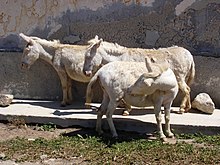Asinara donkey

Asinara donkeys
|
|
| Other names | Asino dell'Asinara |
|---|---|
| Country of origin | Italy |
| Distribution | Sardinia |
| Traits | |
| Distinguishing features | predominantly albinistic |
| Classification | |
| MIPAAF | Breed standard |
|
|
The Asinara donkey, Italian: Asino dell'Asinara (Italian pronunciation: [ˈaːzino dellaziˈnaːra]), is a breed of feral donkey indigenous to the island of Asinara, which lies off the north-west coast of Sardinia, Italy, in the province of Sassari. Most of the population is wholly or partly albinistic; the small number of grey donkeys on the island are also considered part of the population, and are probably heterozygous carriers of the albino gene. The Asinara donkey is one of the eight autochthonous donkey breeds of limited distribution recognised by the Ministero delle Politiche Agricole Alimentari e Forestali, the Italian ministry of agriculture and forestry. It is called ainu, borricu or molenti in Sardinian.
There are approximately 120 individuals on the island. Others are in the natural reserve of Porto Conte in Alghero and at the Istituto di Incremento Ippico at Foresta Burgos, and a few are raised in Tuscany and in Emilia Romagna.
The Asinara donkey probably derives from a chance mutation in the population of Sardinian donkeys abandoned on the island by the inhabitants when they were forcibly evacuated from it following the law of 28 June 1885, under which Asinara was to be transformed into a lazaret and penal colony. It is also possible that the breed descends from white donkeys imported from Egypt in the 19th century by the Duca dell'Asinara.
...
Wikipedia
